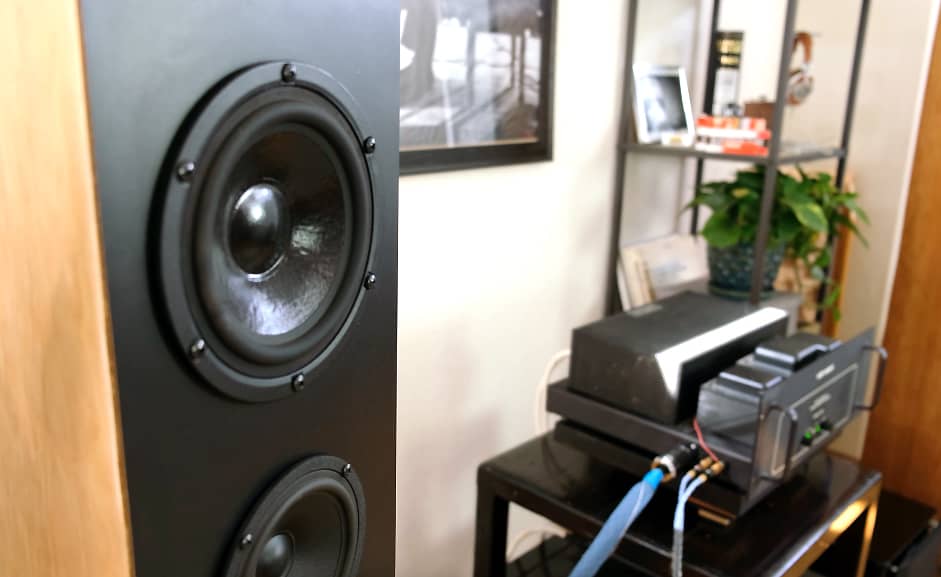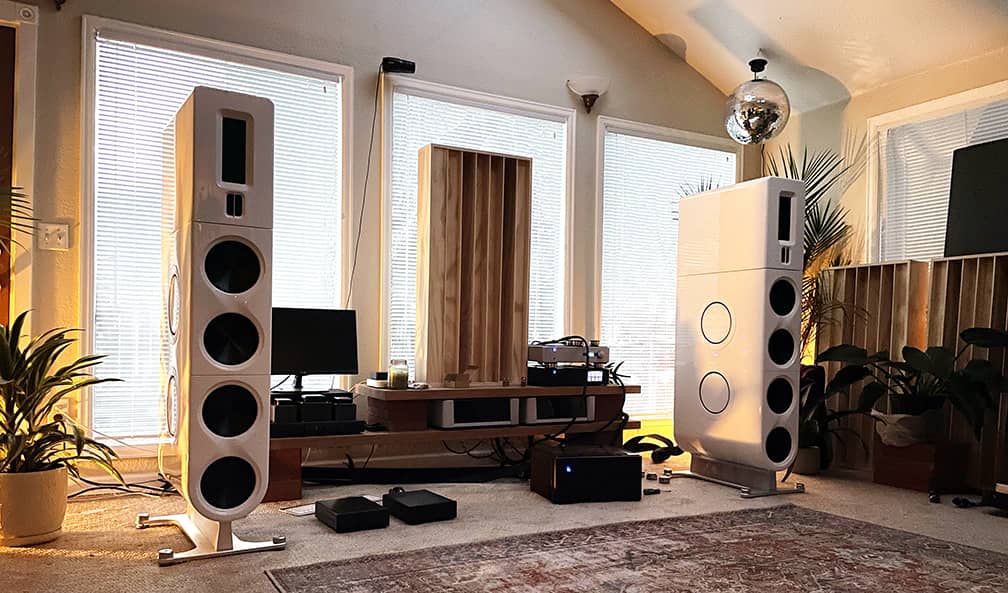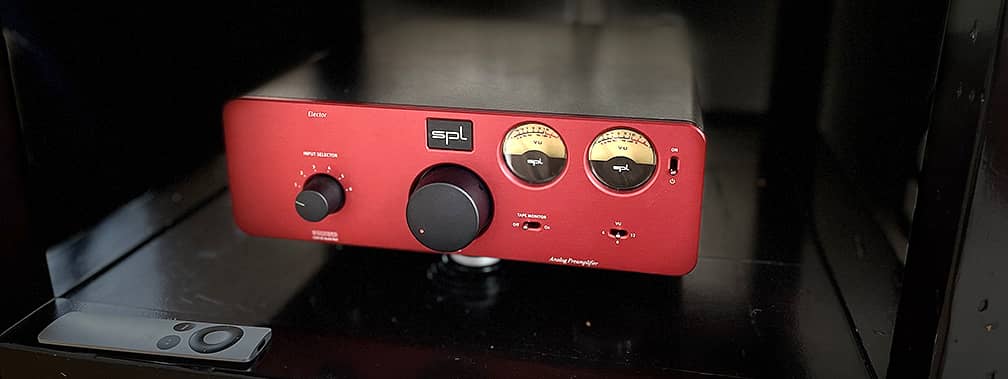TMR Exclusive Review: SPL Elector Preamplifier, Part 4

I performed listening tests across three different HiFi systems. In each system, the same preamplifier was used to compare against the SPL Elector: a $6K PS Audio BHK Signature tube/solid-state hybrid. In each, the tubes were selected previously to be the most synergistic match to that particular system.
Listening Impressions
You may think the doubling of price between these preamplifiers would make it an unfair fight, but throughout these listening tests, I found the battle was almost not fair in the complete opposite direction. I found I really needed to compare the Elector to a higher-end reference preamplifier just to experience some real competition for it.
I listened across three systems because they were quite different and could show how the device would fit into a range of setups. Synergy in the audiophile hobby is essential. I figured that the solid-state Elector would carry different strengths and potentially show more or less synergy in various gear collections. And I was right.

The first system showed a tremendous synergy with the German component compared to the control preamplifier and was very illuminating when trying to understand the Elector. It's my main system, which consists of an Audio Research D115 Mk II amplifier powering 4-ohm, tube-friendly Dunlavy SC-III speakers in a relatively large room. The ceiling above the speakers is about 9-feet off the ground, but above my head at the listening position it extends to 25 feet or more. The left side of the room is completely open, and the rear is as well. My listening couch backs up to a staircase, which provides a bit of asymmetrical diffusion behind me. The source is a PS Audio DirectStream Junior DAC fed via its onboard Ethernet "Bridge" connection as a Roon endpoint.
This system ended up being the best showing and my favorite application of the Elector in any setup. I am generally a huge fan of mixing tubes and solid-state in a HiFi system. Compared to the BHK preamplifier in this system, the extreme noiselessness of the Elector preamplifier delivered much more midrange detail and clarity than I'd ever heard before.
It should be noted that the BHK preamplifier from PS Audio is one of my absolute favorite preamplifiers, and I was using NOS "Bugle Boy" tubes in it, which I'd previously selected for the same qualities of detail and midrange beauty. The BHK is a neutral and musical preamp and uses a very complex and high-end volume control implementation to maintain perfect channel matching and achieve ultra-low capacitance – something no Alps "pot" can boast. To hear the SPL deliver a blacker background and more texture and detail floating around while maintaining the width and depth of the soundstage to which I was accustomed was inspiring.

Omar Sosa and Seckou Keita's album Suba released last October (2021), reveals some of the magic of this gear combination. On track 6, "Voices on the Sea," the opening sound of water splashing had never sounded as realistic. It sounded like I was listening from a sea-going dinghy at oar-level as the strokes moved and disturbed the water around me.
I knew the guitar picks and plucks later in the track had sub-bass weight to them, but I was surprised to finally get the sense of the weight of the piano key strikes early in the track as well. The adjustable-tension "talking drum" throughout also gained a new level of transparency compared to my trusty BHK preamplifier. Truly impressive.
A more solid and accurate bottom end greeted my ears as long as the Elector was in position. After a few hours of listening to this highly synergistic pairing, I realized I could not bear to take it out of the system. It's now been a couple of months since I brought the Elector home, and I've almost saved enough to buy this thing. The Music Room is not getting this beauty back, I can guarantee that!
Moving to "system two" revealed just how low the self-noise is on this special little preamplifier. The second system consists of Wilson Sasha DAW speakers powered by VTV Audio Purifi monaural amplifiers with Sparkos Labs 2590 input buffers. Cabling is almost entirely comprised of AudioQuest Dragon or some other mythical creature. This is a much more expensive collection of gear than my humble system, albeit with relatively inexpensive yet state-of-the-art Class D amplifiers. It boasts supremely low self-noise and speakers that do absolutely nothing to color the sound. It is a true high-end system and an incredible challenge presented to this roughly $3,000 Elector.
However, in this battle, the Elector again proved that it could fight way above its weight class and showed some things that the BHK could not manage. More than in my own system, it showed the sheer joy that listening to that "blacker background" could provide.

Belgian guitar legend Philip Catherine's album from 2011 entitled Philip Catherine Plays Cole Porter was a fitting subject for study, and the third track, "Why Can't You Behave [From Kiss Me Kate]," showed off just how much midrange detail was being left on the table with the $6K tube-based preamp in this specific system.
From the opening dissonance of Philip's second-integer notes to the main theme after 20 seconds, the depth and realism of his softened guitar sound came through so much more naturally than ever before. When you play two notes next to each other in "harmony," the subtle flutter of opposing frequencies stands out. I got the same kind of sense I get when playing guitar like that in my own practice room, and the theme throughout was highlighted with Philip's subtle and slow vibrato. With the Elector in place, I could hear his fingers slowly wiggling to produce that characteristic sustained vibrato much more clearly. The effect was refreshingly honest and inspiring at the same time.
The third and final system was less of a beat-down, to continue this boxing analogy throughout, but it was still a good showing for the beautiful red Elector. PS Audio, located near The Music Room in lovely Boulder, Colorado, has recently begun to produce reference-level speakers as well as electronics. I've been lucky enough to witness some of the development of their first speaker offering, the Aspen FR30, which employs a mix of planar magnetic drivers and dynamic drivers. This third system was anchored by a gorgeous gloss white pair and powered by the company's tube hybrid 250-watt stereo amplifier, designed by the industry legend Bascom H. King – the BHK also behind the preamplifiers I'd been using to compare to the Elector.

In this system, the difference between the BHK preamp and the Elector was perhaps the smallest, and the BHK showed a special synergy in the mix that wasn't as present with my system or the second Wilson-based system. This is important because synergy is the absolute goal in any system when collecting and combining pieces of gear. Perhaps it's because the amplifier and preamplifier in this third system were designed by the same man and voiced together. Maybe the speakers were voiced with these components as well, but there was a sweetness present and a palpability to the transients when the BHK was used instead of the Elector.
The Elector made a great showing to be sure, and interconnect and power cable changes made it inch closer to the BHK, but in the end, it showed a slightly flatter presentation with a little less top-end extension in this system. I remarked to my friend that I'd be happy with the SPL in that position in the system had I not heard what the NOS Amperex "Bugle Boy"-equipped tube hybrid preamp could do.
It was still easy to observe the midrange clarity and lack of grain of the SPL, and the bass response was more accurate with the solid-state device. Still, with the Aspen FR30's excellent ribbon tweeters and large planar midrange working so seamlessly, it was obvious that the BHK had the SPL beat in the depth and "air" category. Synergy is a big deal in the audiophile hobby, and every system is different.
My engineer friend remarked that the capacitance of potentiometers in preamplifiers can tend to show up in areas like this, and perhaps he is right. At this level of HiFi resolution, all of the metal and silicon used in pot design must indeed show its head at some point. This was the first time in a long journey with the SPL that I'd heard anything but absolute synergistic bliss, and that can't be overstated. But it's not surprising that it would not necessarily be the perfect fit in every case.
Conclusion
If I thought I could judge this SPL preamplifier's book by its cover price, so to speak, I was utterly wrong. With the Elector, Neumann and Gier of Sound Performance Lab have created a giant-killer product, one that I doubt will ever leave my system. The SPL's exciting synergy is rare when connected to a high-end tube amplifier. The ultra-low noise presentation of the plucky red preamplifier puts it on par with systems far above its price category. And the ability to present some of the most beautiful and grainless midrange I've heard on one of the most state-of-the-art modern midrange drivers available in those new PS Audio large planars should captivate audiophiles far and wide.
At $2,969 the Elector preamplifier deserves my all-out recommendation as having the best performance for the dollar in high-end audio I've ever witnessed.
Talk with one of our sales staff today about trying out the delicious German gem today, and if you think the red version might stand out too much in your system, think again! I think it stands out just right, as it should.

